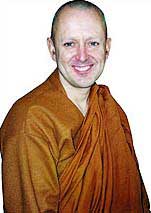A Million Light Offerings for Buddha
By JADE CHAN, The Star, October 27, 2006
Kuala Lumpur, Malaysia -- The Losang Dragpa Buddhist Society (LDC) recently organised a Million Light Offerings event at the Chinese Assembly Hall in Kuala Lumpur.

The annual spiritual event was started in 2001 and is aimed at giving people the opportunity to give offerings to Buddha, which creates extensive merits for the person making the offerings.
A 20-foot structure bearing 840 images of the Buddha at the Mahaboudhi stupa in Bodhgaya was set up so that people could make offerings in the form of flowers, lights or incense.
The three-day event, starting from Oct 20, was presided by Ven KhenRinpoche Lama Lhundhup, the abbot of the renowned Kopan Monastery located at the foothills of the Himalayas in Kathmandu.
KhenRinpoche lit a light during the opening ceremony, a simple act that symbolised him bringing a prayer for all sentient beings.
He also presided over several pujas (prayers), including the Medicine Buddha Puja (prayers for health), Dzambala Pujas (prayers for wealth) and Tara Puja (prayers to attain success for specific projects) and blessed devotees during the first two evenings.
About 10,000 devotees were expected to visit the hall every day, which had been recreated to resemble the pure land with holy relics and objects, lights and flowers.
Devotees took part in various activities like circling the Buddha relics, which helps purify negative karma and creates cause for enlightenment, and spinning the prayer wheel, which resembles a person reciting mantras and helps clear their karma.
According to LDC spiritual co-ordinator Ven. Thubten Dechen, making offerings to Buddha earns merits to help a person overcome obstacles to attain good health and success in work and business.
“The merits can also be dedicated to family members and children so that all their hindrances can be overcome,” she said.
Ven KhenRinpoche said: “A person must establish good motivation when making the offerings. The offering is made not only for yourself but for all sentient beings.
“Only then can you achieve peace, joy and success for whatever you wish for, be it for health, family or business.”
According to him, the different offerings have their own significance.
“A light offering to Buddha signifies wisdom and enlightenment. By attaining knowledge and enlightenment, you’ll be able to easily remove obstacles and the main causes of ignorance.
“A person who makes light offerings is making dedications for everyone. Its benefit is not just for this life but for all future lives until you achieve enlightenment.
“A flower offering to Buddha creates cause for you to have good rebirth. When you get a rebirth, you are reborn as a human being in circumstances where you can practise kindness, such as having good health and good body to help people.”
“An incense offering allows you to be able to appease local deities and gives protection to all living beings. It also helps remove delusions, obstacles and negative actions in a living being’s mind.
“The incense’s good smell signifies pure conduct. When you remove negative karma, you’ll not harm others and try to help others if possible.”
The Mahayana magazine, LDC’s inaugural magazine which features stories and interviews related to Buddhism, was also launched at the event.
 "Last month, a Catholic priest in Adelaide phoned me especially to thank me for the book because he uses it in his chaplaincy work," Ajahn Brahm says, sounding both delighted and a bit amazed. "When you get praise from Christians, you think, wow, this book is actually making those bridges between different religions."
"Last month, a Catholic priest in Adelaide phoned me especially to thank me for the book because he uses it in his chaplaincy work," Ajahn Brahm says, sounding both delighted and a bit amazed. "When you get praise from Christians, you think, wow, this book is actually making those bridges between different religions."